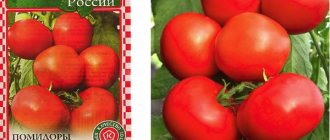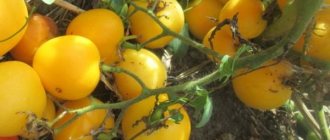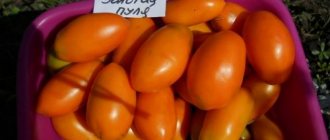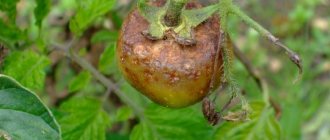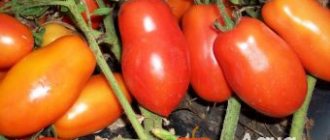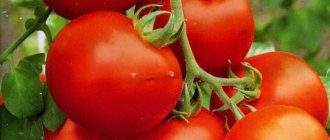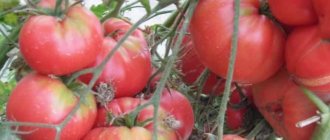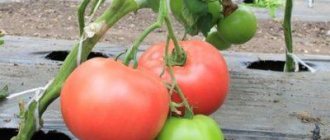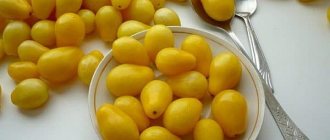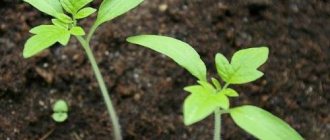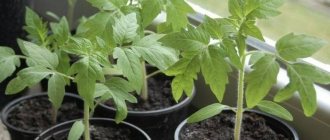Summer residents in the northern regions usually have difficulty selecting tomato varieties. The 100 percent F1 hybrid tomato deserves attention. It is adapted to difficult climatic conditions and has time to ripen even in the short northern summer.
| Height | Landing location | Ripening time | Fruit color | Fruit size | Origin | Fruit shape |
| Medium height | Open ground | Early ripening | Reds | Average | Hybrid | With spout |
Characteristics and description of the variety
An early-ripening hybrid with an intriguing name, 100% is distinguished, first of all, by its uniqueness, since it can be grown simultaneously in a greenhouse and in open ground.
Experts highly value the taste and characteristics of this salad vegetable. Its main feature is high immunity, good resistance to diseases and garden pests. It is important! We can talk about good immunity and high yield if the tomatoes were grown from special seed material, and not from seeds from last year’s harvest.
A 100% tomato bush reaches a height of 1.3-1.5 meters, which means that supports will be required for the normal development of the bush. Also, to obtain good harvests, the bushes will have to be pinched. The leaves and inflorescences of the plant have a simple shape.
Advantages and disadvantages
Pros:
- Early ripening of tomatoes helps the plant avoid many diseases that appear in the second half of summer.
- Excellent immunity.
- Rich taste.
- Good yield from one bush.
Minuses:
- The crop's stem is quite tall and difficult to process.
- Needs additional fixation to prevent the plant from breaking.
- Constant feeding with mineral fertilizers.
Height, plant weight, color, shape
According to external data, the tomato variety is 100 percent similar to most of its relatives - the rounded fruits are red in color, and the distinctive feature is the protrusion (spout) located in the upper part. The weight of individual fruits ranges from 150-190 grams, but larger specimens are quite common. The fruits are quite dense and fleshy, while they have an excellent sweet and sour taste and are suitable for use fresh or canned.
The main purpose of the variety
The value of tomatoes lies, first of all, in the presence of vitamins and other useful substances in them. 100% tomato is no exception, which is ideal for preparing vegetable vitamin salads. It is also a good base for various, including gourmet, sauces. Tomatoes of this variety are perfectly stored and are suitable for various types of preservation - separately and in combination with other vegetable crops.
Productivity
If you follow the technology for preparing seedlings and planting them in the ground, you can count on high yields. Each bush during the fruiting season can produce up to 5 kilograms of mature fruits, which means that from each square meter where 4-5 bushes are usually planted, you can harvest up to 20 kilograms of harvest, and this is a unique result.
In what regions is it grown?
Despite the fact that the project was developed 100 percent primarily for the northern regions of Russia, it shows excellent results in warm regions and in central Russia. The difference is that at low temperatures it is advisable to use film, and if the temperature allows, do not forget that 100% loves the sun's rays, so you should not deprive it of the opportunity to “bask” in the sun.
Care
- Tomatoes should be watered no more than 2 times a week. Less frequent on days of heavy rain. Water is poured at the root. It should be warm and settled throughout the day.
- The soil needs to be loosened and the stems hilled, allowing the formation of new roots. The soil should not be crusty. For a softer consistency, you can add sawdust.
- Timely weeding will prevent the root system of vegetables and weeds from becoming mixed up.
- If the plant grows indoors, it is important to ventilate the greenhouse or greenhouse daily.
- To prevent common diseases and pest invasions, bushes are sprayed. Unfortunately, in many regions there are invasions of flies, mole crickets, slugs, aphids, Colorado potato beetles and even crickets on tomatoes. Therefore, timely processing will save the crop from destruction. It will also prevent the development of viral and fungal infections.
Every gardener knows that the more attention you pay to a plant, the greater its return and reward in the form of fruits. Proper care will help you get the maximum yield from such a wonderful “100 percent” variety.
tomato Purple candle - description and characteristics of the variety
Features of growing and caring for the variety
Like other varieties of tomatoes, it is 100% preferable to plant tomatoes in open ground in the form of seedlings, which must be grown properly. First of all, for this you need to use seed material purchased in specialized stores. It is also advisable to buy special soil, which is best calcined in the oven before planting seeds.
Planting time for seedlings
As a rule, seedlings are planted in the first ten days of March, although gardeners often begin to worry about the future harvest at the end of winter. It is more correct, however, to plant seeds approximately 55-60 days before the expected harvest. After two leaves appear, it is time to pick the plant. As soon as strong shoots appear, they are transplanted into separate containers, and the result now depends on timely watering and high-quality fertilizing. If the sprouts do not have enough sunlight, you can use artificial lighting, and to strengthen the immune system, it is advisable to take the growing plants out into the fresh air.
Maturation speed
Tomato sprouts will gain strength until mid-May, when they can be planted in open ground. To do this, the soil must be pre-treated, and for this it is plowed in the fall. Repeated plowing is done in the spring, after which peat, manure and other fertilizers are added and watered. Strong sprouts with a hard stem and dense foliage can be planted in pre-prepared holes.
The distance between neighboring bushes should not be less than 40 centimeters - this way each bush will receive adequate nutrition.
After planting the seedlings in the prepared soil, you can forget about them for a week - the sprouts must adapt to the new conditions. After a week, the seedlings can be watered and the soil can be loosened. Fertilizers can be used from the appearance of the first ovary. Tomatoes love moisture, but you should stop watering a week before harvest, as the wateriness of the fruit will increase. Tomatoes should be watered twice a week, at least, but the root system should not be flooded. The soil should not be hard and worn down, and there should be no place for weeds in the garden bed.
A comfortable temperature should be maintained in greenhouses and greenhouses, and do not forget to ventilate the room. If necessary, it is worth doing pinching, and to hold heavy bushes you will have to tie them up and strengthen them with improvised means. Tomatoes need to be fed approximately five times during the ripening season, and they really love peat, manure and chicken droppings. Unlike late- and mid-ripening varieties, the ripening of which begins 100-120 days after planting the seeds, tomatoes 100 percent please summer residents and gardeners already on the 80th day. The harvest continues until mid-September.
You can get the highest possible yield by planting tomatoes 100 percent at some distance from equal plants. It is best to have garden herbs, onions and sweet peppers growing nearby.
Growing
Sow tomatoes in special trays or boxes for seedlings. First, the seeds are disinfected with a manganese solution for 10 - 15 minutes. Then they are placed in a hole or trench to a depth of 1 - 1.5 cm and at a distance of 2 - 3 cm from each other. The containers are covered with polyethylene or a piece of glass. After pecking, the shelter is removed, and the seedlings are placed on the windowsill, using additional lighting with a fluorescent lamp. With the appearance of the second true leaf, the seedlings are pruned. Each sprout is placed in a separate pot.
Before transferring the seedlings to the ground, they are hardened off for 2 weeks. You can take it outside for a while or open a window indoors. Tomatoes are transplanted in mid-May, depending on the region, into open or closed ground. When placing bushes in the ground, it is necessary to maintain a distance between them - at least 40 cm from each other.
The soil is prepared in advance. Starting in the fall, it is dug up in large pieces and left to freeze for the winter to kill some of the parasites and diseases. In the spring, the soil is dug up again, manure, humus, peat and ash are added. Next, dig holes and spill them with water. It is better not to touch the transplanted plants for a week. After a while, you can loosen the soil, water and add mineral fertilizers. Like many other tomatoes, “100 percent” loves nitrogen, phosphorus and potassium.
When the tomatoes are all ripe and the last fruits remain, stop watering. Not watering will help make the vegetables firmer and less watery. Such fruits will be stored longer.
During the plant season and fruit ripening, timely care is important: watering, fertilizing, loosening and mulching the soil.
Festive tomato - description and characteristics of the variety
Resistance to diseases and adverse conditions
By creating a 100% hybrid, breeders used only the best qualities of tomatoes of different varieties, so it has, among other things, high immunity and is protected from pathogens and pests. Insects that can cause trouble include mole crickets, slugs, flies and ticks. To get rid of them, special preparations are used that are considered harmless to the plant itself and humans, respectively. Some microbes thrive in acidic environments, so don't let your soil become too acidic. You can check it using an acidity meter. If it was not possible to avoid encountering pests, the affected fruits should be immediately picked and destroyed.
Storage rules
Considering the sufficient density of the fruit, we can talk about a relatively long shelf life, and at room temperature. Tomatoes can stay indoors for 2-3 months, but many people prefer to make delicious juice from them; they prepare delicious adjika, lecho and other juices and seasonings based on them. They are also good in canned form - they are sealed separately and added to vegetable salads.
Reviews from those who planted
Svetlana, Lugansk
“I was told that tomatoes have 100% increased immunity to diseases and protection from pests, but I didn’t take any risks and fertilized it well before planting it in the ground. Not only did almost all the seeds sprouted, each bush produced at least 5 kilograms, if not more. I’m very pleased with the variety, I’m thinking of expanding the greenhouse.”
Ilya, Rostov-on-Don
“This is the second year I have been planting 100 percent tomatoes, and for the second year already in mid-July I am delighting my household with organic tomatoes that have a great taste and aroma. It’s not difficult to care for them - pinching skills will come in handy, and you can’t do without tying up the bushes.”
Review
Viktor Nikolaevich, Bratsk I live in Siberia and have built my own greenhouse for several years now, growing tomatoes in it. The President planted it for the first time and was very surprised by this tomato (in a good way). The bushes grew into two stems, as indicated on the bag of seeds. He constantly cut off his stepchildren. I fed it often, mostly using organic matter (mullein diluted in water). Although this tomato is early, it bore fruit for me until the Siberian autumn, or, more precisely, until mid-October. And then, I had to pull out the still green bushes with new ovaries, since frosts began, the greenhouse had to be dismantled. Those tomatoes that I picked green and brown ripened perfectly in the house. Some of them stayed in the refrigerator until December 10th! I highly recommend this variety and will definitely grow it again myself.
